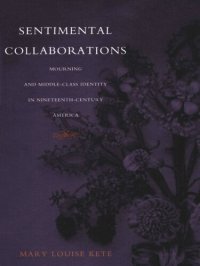
Ebook: Sentimental Collaborations: Mourning and Middle-Class Identity in Nineteenth-Century America
Author: Mary Louise Kete
- Year: 2000
- Publisher: Duke University Press
- Language: English
- pdf
During the 1992 Democratic Convention and again while delivering Harvard University’s commencement address two years later, Vice President Al Gore shared with his audience a story that showed the effect of sentiment in his life. In telling how an accident involving his son had provided him with a revelation concerning the compassion of others, Gore effectively reconstructed himself as a typical, middle-class American for whom sympathy can lead to salvation. This contemporary reiteration of mid-nineteenth-century American sentimental discourse proves to be a fruitful point of departure for Mary Louise Kete’s argument that sentimentality has been an important and recurring form of cultural narrative that has helped to shape middle-class American life.
Many scholars have written about the sentimental novel as a primarily female genre and have stressed its negative ideological aspects. Kete finds that in fact many men—from writers to politicians—participated in nineteenth-century sentimental culture. Importantly, she also recovers the utopian dimension of the phenomenon, arguing that literary sentimentality, specifically in the form of poetry, is the written trace of a broad cultural discourse that Kete calls “sentimental collaboration”—an exchange of sympathy in the form of gifts that establishes common cultural or intellectual ground. Kete reads the work of Ralph Waldo Emerson, Henry Wadsworth Longfellow, Mark Twain, Harriet Beecher Stowe, and Lydia Huntley Sigourney with an eye toward the deployment of sentimentality for the creation of Americanism, as well as for political and abolitionist ends. Finally, she locates the origins of sentimental collaboration in the activities of ordinary people who participated in mourning rituals—writing poetry, condolence letters, or epitaphs—to ease their personal grief.
Sentimental Collaborations significantly advances prevailing scholarship on Romanticism, antebellum culture, and the formation of the American middle class. It will be of interest to scholars of American studies, American literature, cultural studies, and women’s studies.
Many scholars have written about the sentimental novel as a primarily female genre and have stressed its negative ideological aspects. Kete finds that in fact many men—from writers to politicians—participated in nineteenth-century sentimental culture. Importantly, she also recovers the utopian dimension of the phenomenon, arguing that literary sentimentality, specifically in the form of poetry, is the written trace of a broad cultural discourse that Kete calls “sentimental collaboration”—an exchange of sympathy in the form of gifts that establishes common cultural or intellectual ground. Kete reads the work of Ralph Waldo Emerson, Henry Wadsworth Longfellow, Mark Twain, Harriet Beecher Stowe, and Lydia Huntley Sigourney with an eye toward the deployment of sentimentality for the creation of Americanism, as well as for political and abolitionist ends. Finally, she locates the origins of sentimental collaboration in the activities of ordinary people who participated in mourning rituals—writing poetry, condolence letters, or epitaphs—to ease their personal grief.
Sentimental Collaborations significantly advances prevailing scholarship on Romanticism, antebellum culture, and the formation of the American middle class. It will be of interest to scholars of American studies, American literature, cultural studies, and women’s studies.
Download the book Sentimental Collaborations: Mourning and Middle-Class Identity in Nineteenth-Century America for free or read online
Continue reading on any device:

Last viewed books
Related books
{related-news}
Comments (0)